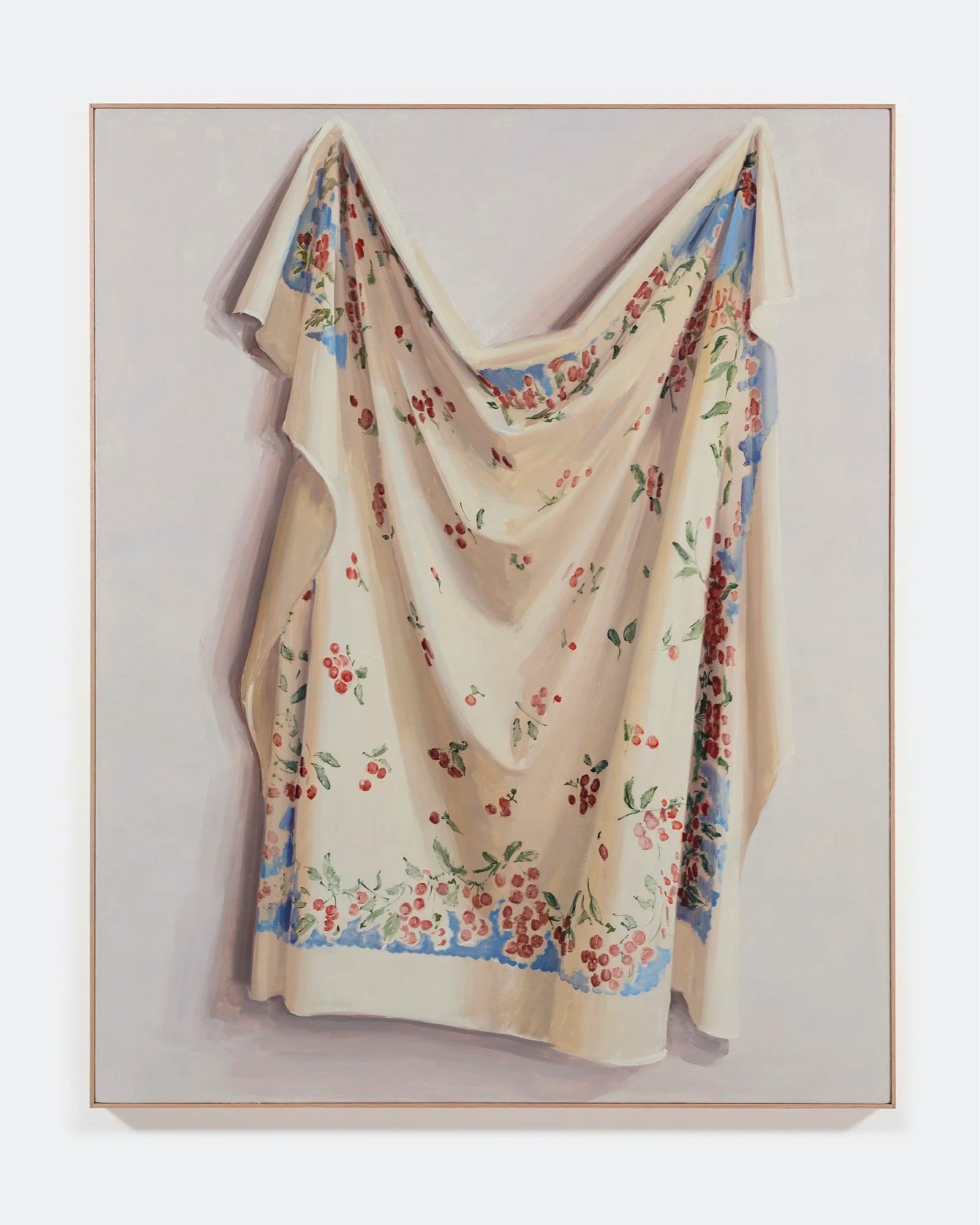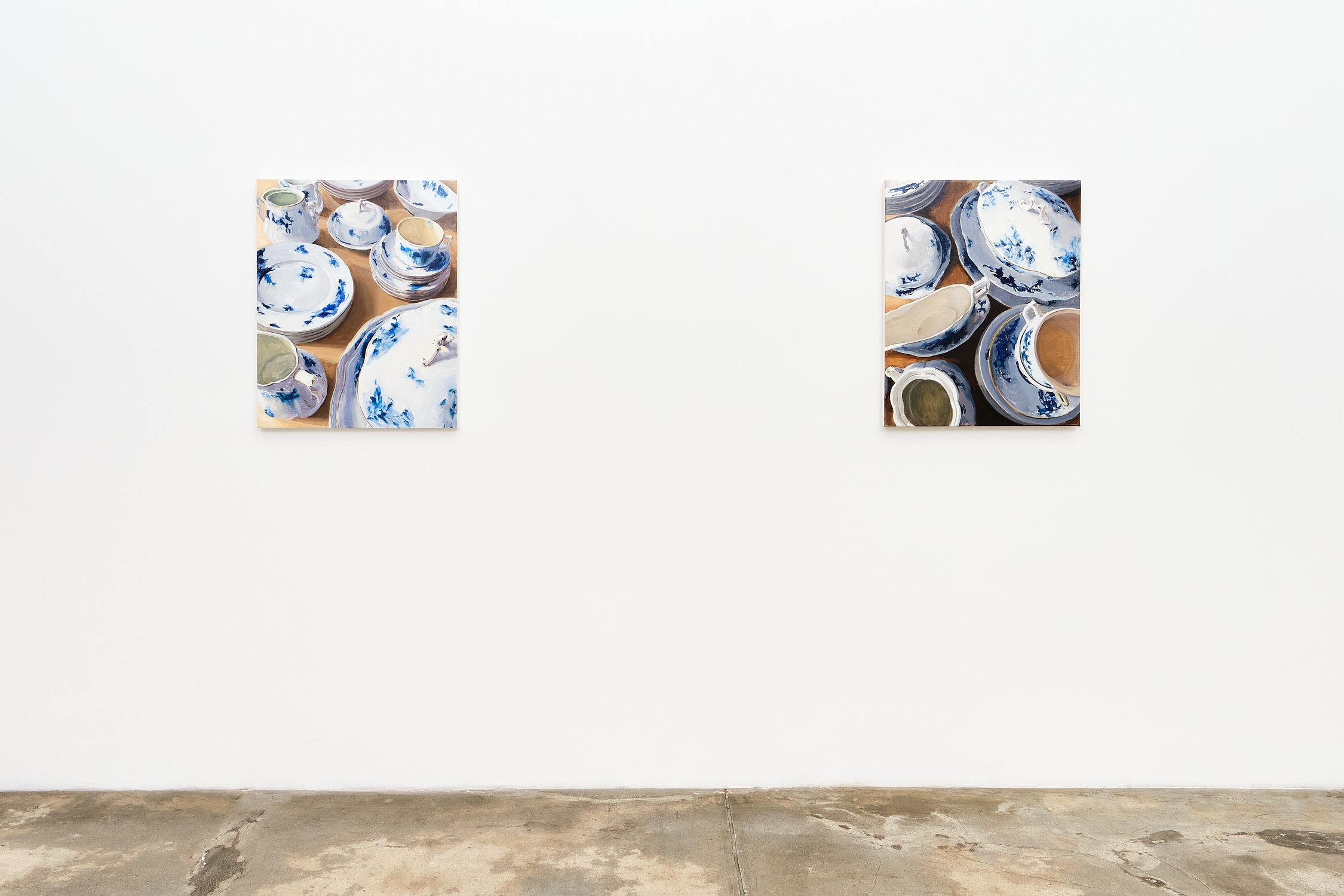Lowell Ryan Projects is pleased to present If for Once We Could Do Nothing, an online exhibition of paintings by Carrie Mae Smith. Taking its title and sensibility from Pablo Neruda’s poem “Keeping Quiet,” the exhibition considers what it means to be still in a time of noise—to listen, to look, and to remember the quiet labor of care.
In this body of work, Smith continues her engagement with still life painting as both a meditative and a subversive practice. Her compositions—tablecloths draped and folded, freshly picked peas in a basket, peaches glowing against a patterned cloth—speak softly but insistently. They are not nostalgic recreations of domesticity, but careful reanimations of the simplicity of nourishment and ritual. “Perhaps the earth can teach us,” Neruda writes, “as when everything seems dead and later proves to be alive.” Smith’s paintings follow that instruction, seeking vitality in stillness and meaning in the everyday.
Many of her motifs emerge from materials steeped in memory. The tablecloths are borrowed from a friend’s collection, once belonging to her mother—intimate artifacts that hold the invisible record of gendered labor. Their floral prints ripple and distort across large canvases, their forms abstracting into fields of color and light. Through scale and attention, Smith restores significance to the overlooked. Her approach to still life aligns her with painters such as Jean Siméon Chardin, Giorgio Morandi, Janet Fish, and Lois Dodd, who each found quiet radicality in ordinary subjects. Yet Smith’s focus on cultivation and care places her within contemporary dialogues on sustainability, feminism, and the ethics of attention. Her paintings suggest that to look closely—to truly see—is itself a political act.
Smith reflects: “I’ve been thinking about time and beauty. How, a century ago, lives were shorter but perhaps more connected to land, to craft. Singer sewing machines adorned with floral inlays, mason jars of preserved tomatoes—a kind of beauty born not of abundance, but of care.” In her twenties, Smith left college to work on organic farms across southern Europe, including Spain, Italy, and France, as well as in Martha’s Vineyard, MA, inspired by Helen and Scott Nearing’s The Good Life. That period of physical labor and cultivation continues to shape her worldview. In the studio, she brings the same patience and attention that once guided her in the field: planting, tending, waiting. Amid technological acceleration and climate anxiety, painting what she has grown or gathered becomes, in her words, “a radical offering of presence.”
The paintings in If for Once We Could Do Nothing provide a moment of suspension. Without prescribed solutions or answers, they capture a feeling of stillness and for noticing the delicate pulse of life that persists beneath the surface of the digital era. In Smith’s hands, painting becomes a form of listening: to the earth, to memory, and to the quiet wisdom of the past. Beauty here does not clamor for attention. It resides, gently, in the act of paying attention itself.
“If we were not so single-minded
about keeping our lives moving,
and for once could do nothing,
perhaps a huge silence
might interrupt this sadness
of never understanding ourselves
and of threatening ourselves with death.
Perhaps the earth can teach us
as when everything seems dead
and later proves to be alive.”
from “Keeping Quiet” by Pablo Neruda
Carrie Mae Smith
Blue Roses
October 26- November 30, 2024
LOWELL RYAN PROJECTS
4619 W Washington Blvd.
Los Angeles, CA 90016
Installation view: Carrie Mae Smith, Blue Roses
Lowell Ryan Projects is pleased to present our second solo exhibition by Upstate New York-based artist Carrie Mae Smith. The exhibition, titled Blue Roses, features a series of still life paintings depicting a particular set of flow blue china in W.H. Grindley's Rose pattern (c. 1893). This series represents a progression in Smith's artistic practice, showcasing her evolving formal techniques while continuing her exploration of the history and significance of domestic utilitarian objects, especially culinary items.
A particular favorite of Smith’s because of its imperfect patterns and soft painterly designs, she set up various arrangements of blue flow china for her painting compositions. Atop tables in her light-filled studio, the arrangements appear almost as if the china pieces had just been placed out in preparation for setting the table for a special dinner. Serving vessels are nestled between stacks of plates and cups and saucers, forks and knives are cradled in dishes or placed as a pair on dinner plates. Most of the works are painted looking down upon the china, or at an angle from above, allowing Smith to capture the delicate patterns both on top of the plates and on the sides of the pitchers and cups. The rich blue patterns on cool white china are set against the beige tones of a warm linen tablecloth, the light from the window casting soft shadows between the dining and serving ware.
“With my still-life paintings, I aim to highlight the inherent beauty of these items, viewing the arrangements of stacked china as contemplative spaces,” Smith explains. “As I arranged the compositions and painted this series, I found myself reflecting on the family who once owned these pieces, the meals lovingly prepared and served on these dishes, the care taken to clean and store them, and the cabinet where they waited patiently for the next special occasion. My thoughts also wandered to the cultural weight these items carry and how changing lifestyles have diminished the significance of formal traditions over time.”
While Smith’s artistic practice touches on various social and political concepts and ideas, the works in Blue Roses enable the viewer to relish in the beauty of both her painterly style and her ability to further extend the lifecycle of these elegant items.
inquire: info@lowellryanprojects.com
Installation view: Carrie Mae Smith, Blue Roses
Installation view: Carrie Mae Smith, Blue Roses
Installation view: Carrie Mae Smith, Blue Roses
Installation view: Carrie Mae Smith, Blue Roses
Installation view: Carrie Mae Smith, Blue Roses
Installation view: Carrie Mae Smith, Blue Roses
Installation view: Carrie Mae Smith, Blue Roses
Installation view: Carrie Mae Smith, Blue Roses
Installation view: Carrie Mae Smith, Blue Roses
Installation view: Carrie Mae Smith, Blue Roses
Installation view: Carrie Mae Smith, Blue Roses
Carrie Mae Smith
Four Plates and Four Forks
February 18- March 18, 2023
LOWELL RYAN PROJECTS
4619 W Washington Blvd.
Los Angeles, CA 90016
Installation view: Carrie Mae Smith, Four Plates and Four Forks
Lowell Ryan Projects is pleased to present a solo exhibition titled, Four Plates and Four Forks, by Upstate New York-based artist Carrie Mae Smith. Composed of recent small-scale paintings of various cutlery, china, cuts of meat, pastries, and domestic interior scenes softly rendered in oil paint, these works continue Smith’s exploration of domestic utilitarian objects, particularly with an interest in culinary articles and their social and historical implications. This will be Carrie Mae Smith’s first solo exhibition in Los Angeles and with the gallery.
Shape, light, color, and composition are meticulously explored in these luminous works, which are rendered in shades of blue, cream, gold, pinks, and saturated reds. These quiet paintings highlight the formal simplicity of a teacup and saucer, the abstract beauty of an uncooked lamb chop, and the exquisite sweetness of a lush square of cream sandwiched between layers of puff pastry. The daughter of a butcher, Smith supported her artistic practice early on working as a private chef. Quiet moments alone in the kitchen precipitated the contemplation of ingredients, serving ware, and culinary implements, as well as the meaning that can be associated with them. Fine china and silver have long been symbols of status, family, tradition, and history, while expensive cuts of meat and delicate pastries are not foods of the working class. As Smith’s focus has primarily shifted to her artistic practice, she continues however to contemplate the subtle meanings of these items in her work.
While savoring the act of painting, Smith’s process also references the gesture of serving. The act of serving a meal or a cup of tea now applies to family, friends, and loved ones, but through her paintings extends to the viewer as well. In the title work of the exhibition, Four Forks and Four Plates, 2022 a stack of four gold and teal-rimmed plates rest on a beige surface. Two forks are on top of the stack and two forks rest next to the plates as if waiting to be set out on the table in preparation for dinner, or possibly dessert. The soft cast of daylight reflects from the tongs of the forks and extends an almost lavender-hued shadow off the side of the china. The softness of Smith’s brushwork alludes to the effortless nature of setting down the plates and knives on the table, almost as if a second-nature movement. While the skill of Smith’s brushwork and the process of setting a table are not instinctive acts, but instead the result of years of practice, attention to detail and refinement, Carrie Mae Smith’s works allow the viewer to surrender to her process and relish in the moment of reflection and anticipation.
inquire: info@lowellryanprojects.com
Installation view: Carrie Mae Smith, Four Plates and Four Forks
Installation view: Carrie Mae Smith, Four Plates and Four Forks
Installation view: Carrie Mae Smith, Four Plates and Four Forks
Installation view: Carrie Mae Smith, Four Plates and Four Forks
Installation view: Carrie Mae Smith, Four Plates and Four Forks
Installation view: Carrie Mae Smith, Four Plates and Four Forks
Installation view: Carrie Mae Smith, Four Plates and Four Forks
Installation view: Carrie Mae Smith, Four Plates and Four Forks
Installation view: Carrie Mae Smith, Four Plates and Four Forks
Installation view: Carrie Mae Smith, Four Plates and Four Forks






























